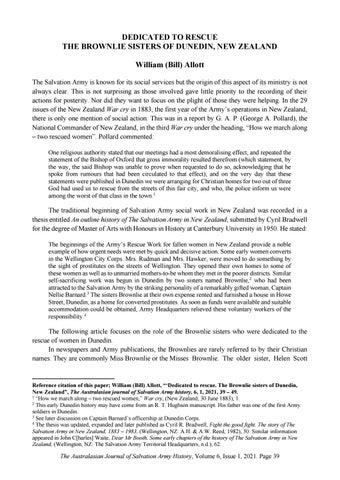DEDICATED TO RESCUE THE BROWNLIE SISTERS OF DUNEDIN, NEW ZEALAND William (Bill) Allott The Salvation Army is known for its social services but the origin of this aspect of its ministry is not always clear. This is not surprising as those involved gave little priority to the recording of their actions for posterity. Nor did they want to focus on the plight of those they were helping. In the 29 issues of the New Zealand War cry in 1883, the first year of the Army’s operations in New Zealand, there is only one mention of social action. This was in a report by G. A. P. (George A. Pollard), the National Commander of New Zealand, in the third War cry under the heading, “How we march along – two rescued women”. Pollard commented: One religious authority stated that our meetings had a most demoralising effect, and repeated the statement of the Bishop of Oxford that gross immorality resulted therefrom (which statement, by the way, the said Bishop was unable to prove when requested to do so, acknowledging that he spoke from rumours that had been circulated to that effect), and on the very day that these statements were published in Dunedin we were arranging for Christian homes for two out of three God had used us to rescue from the streets of this fair city, and who, the police inform us were among the worst of that class in the town.1
The traditional beginning of Salvation Army social work in New Zealand was recorded in a thesis entitled An outline history of The Salvation Army in New Zealand, submitted by Cyril Bradwell for the degree of Master of Arts with Honours in History at Canterbury University in 1950. He stated: The beginnings of the Army’s Rescue Work for fallen women in New Zealand provide a noble example of how urgent needs were met by quick and decisive action. Some early women converts in the Wellington City Corps. Mrs. Rudman and Mrs. Hawker, were moved to do something by the sight of prostitutes on the streets of Wellington. They opened their own homes to some of these women as well as to unmarried mothers-to-be whom they met in the poorer districts. Similar self-sacrificing work was begun in Dunedin by two sisters named Brownlie,2 who had been attracted to the Salvation Army by the striking personality of a remarkably gifted woman, Captain Nellie Barnard.3 The sisters Brownlie at their own expense rented and furnished a house in Howe Street, Dunedin, as a home for converted prostitutes. As soon as funds were available and suitable accommodation could be obtained, Army Headquarters relieved these voluntary workers of the responsibility.4
The following article focuses on the role of the Brownlie sisters who were dedicated to the rescue of women in Dunedin. In newspapers and Army publications, the Brownlies are rarely referred to by their Christian names. They are commonly Miss Brownlie or the Misses Brownlie. The older sister, Helen Scott
Reference citation of this paper; William (Bill) Allott, “‘Dedicated to rescue. The Brownlie sisters of Dunedin, New Zealand”, The Australasian journal of Salvation Army history, 6, 1, 2021, 39 – 49. 1 “How we march along – two rescued women,” War cry, (New Zealand, 30 June 1883), 1. 2 This early Dunedin history may have come from an R. T. Hughson manuscript. His father was one of the first Army soldiers in Dunedin. 3 See later discussion on Captain Barnard’s officership at Dunedin Corps. 4 The thesis was updated, expanded and later published as Cyril R. Bradwell, Fight the good fight. The story of The Salvation Army in New Zealand, 1883 – 1983, (Wellington, NZ: A.H. & A.W. Reed, 1982), 50. Similar information appeared in John C[harles] Waite, Dear Mr Booth, Some early chapters of the history of The Salvation Army in New Zealand, (Wellington, NZ: The Salvation Army Territorial Headquarters, n.d.), 62.
The Australasian Journal of Salvation Army History, Volume 6, Issue 1, 2021. Page 39













